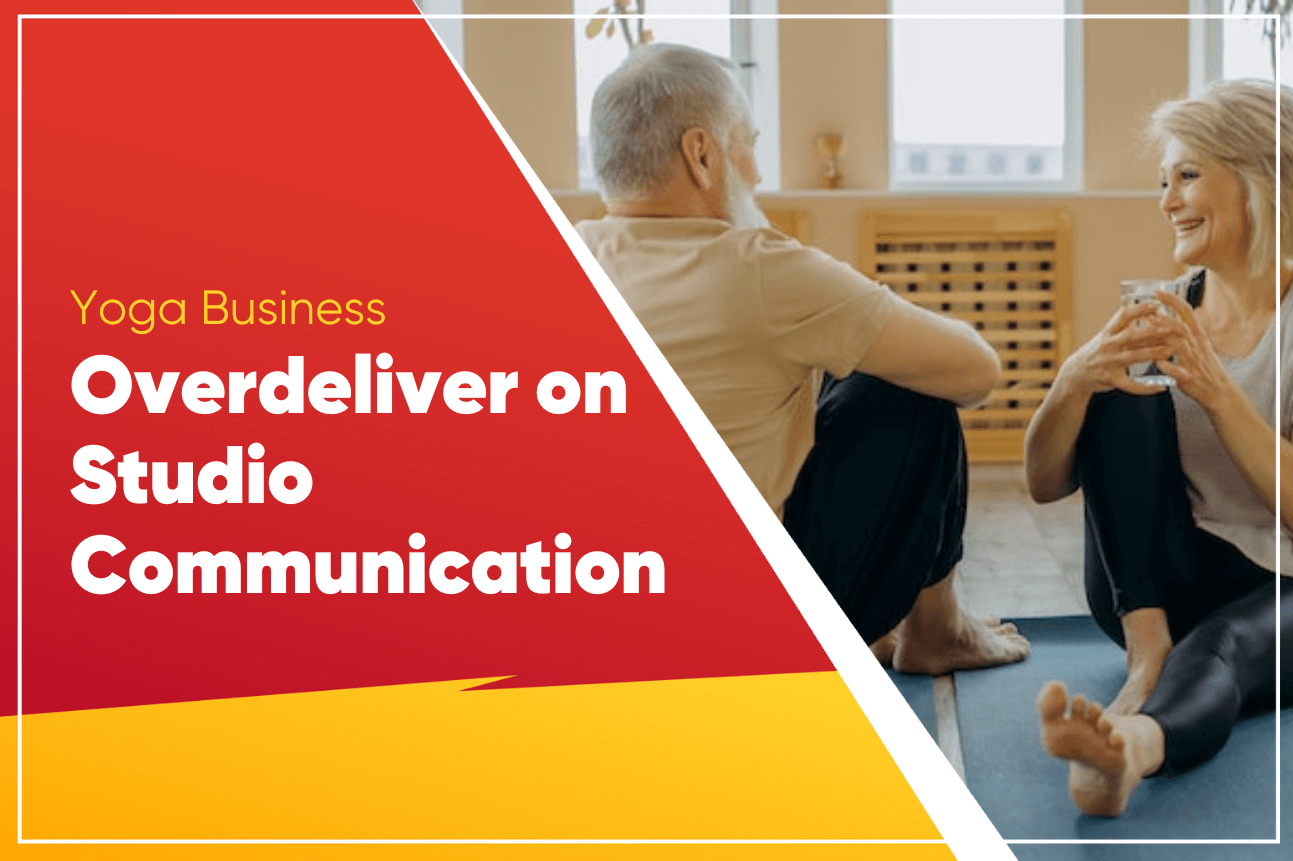All businesses can benefit from clear and consistent communication with their customers. As a service provider, yoga studios are no exception. Yoga members expect to be kept up-to-date on what is happening around the studio, future events, pricing changes, and more. However, you’ll want to remember that daily conversations with members are also an important component of client communication.
It can be easy to assume you’re doing a great job of communicating with your members. Most studios have social media pages, post flyers with announcements at the studio, and maintain a member email list. Nevertheless, it can be beneficial to evaluate your communication channels to ensure that you are best serving your members. Don’t strive for adequate; strive to over-deliver on communication.
What is Member Communication?
Plainly stated, member communication is any form of communication between the studio (including teachers and staff) and the members. This includes mass communication methods like emails or social media posts, but it also includes individual chats with members.
Some of the most common forms of communication include:
- Emails
- Social media pages
- Facebook group
- Messaging application
- Signs and flyers at the studio
- Conversations between staff and members
- Announcements before or after classes
Why is Member Communication at Your Yoga Studio Important?
The reason you want to make sure that you are effectively communicating with your studio members is to increase (or at least maintain) member satisfaction. Of course, you want happy members, because happy members stick around. Acquiring new customers costs on average five times more than retaining existing customers. Satisfied members stick around and recommend the studio to their friends and family.
Communicating with everyone also helps your studio to run more smoothly. When everyone is aware of events, changes to the schedule, new teachers, etc., there will be fewer interruptions or issues with studio operations.
During individual conversations, you and your staff are building personal relationships with your members. When staff and members get to know each other, you can build a stronger community bond. Clients will feel more attached and involved with the studio.
When members feel welcome, they are more likely to attend more classes. This motivation can help them reach their health and fitness goals.
How to Over-Deliver on Yoga Member Communication
These are a few suggestions for ways that you can ensure that your yoga studio is over-delivering on member communication. If you realize that your studio is missing some of these components, work on implementing one at a time. You don’t want to get overwhelmed by trying to do too many things at once and your members will appreciate one change at a time.
Communication Methods
You’ll need to find the right combination of communication methods that work for your studio and your members. Some studios like to use several methods, while others prefer to stick to one or two.
Everyone has an email account, so this is one of the most reliable ways to pass information to your clients. However, you can’t always ensure that everyone opens and reads their emails from the yoga studio. Regardless, most studios like to use email for monthly newsletters or announcements.
Depending on how your membership sign-up process works, you have most likely collected everyone’s email already. With yoga studio management software, you can keep all your member contact information, including email and addresses, in one easy-to-access location.
Text Messages and Phone Calls
Nowadays, most people have smartphones or at least utilize a mobile phone. Mass text messages can be a great way to get urgent announcements out to the entire studio. On the other day, using text messages for frequent (and non-urgent) announcements can annoy and overwhelm members.
When it comes to mass communication, robocalls are less frequently used by yoga studios. Like a mass text message for urgent news, pre-recorded phone messages can be sent out to all your members if you need to quickly communicate with them.
Personal phone calls and text messages can also be a helpful way to communicate with members who do not have extra time to talk before or after classes. The longer you work with a client, the better you’ll get to know their communication preferences.
Messaging Applications
Mobile yoga studios and personal trainers frequently use messaging applications, like WhatsApp, to communicate with their members. One of the reasons for this is that some people have issues creating group chats between Apple and Android phones.
A drawback to using a messaging application is that your members need to have a smartphone and download a new application. If they do not have notifications turned on, they may not stay up to date on information.
Physical Signage
Since your members are coming into the studio for their classes, putting up flyers or posters with information is an easy way to get out information. Usually, this is done for events that are coming up in the future. Low-priority information can also be spread this way since it is not time-sensitive.
Remember that not everyone will be looking around the studio or checking out an announcement board. Physical signs should never be used as your primary source of communication.
Class Announcements
Before and after classes are periods when members are in the studio but not actively focused on class. Use this time to get out any important messages. Don’t take up too much time though. Let members know that they can see a teacher or staff member if they want more information or have any questions.
You’re probably used to members running into the studio right as class is starting. For this reason, the time after class can be better for announcements.
Social Media and Facebook Groups
Social media pages are usually used as a marketing tool. They are great for showing off your studio and encouraging new clients to check it out. If your members are active on social media, they most likely follow your studio pages. You can use these pages to communicate with your members, but keep in mind that potential customers or non-customers may also be following these accounts.
Facebook groups are a helpful way to communicate with many of your members. Most people have a Facebook account, whether they are active on it or not. Group chats not only allow you to talk to your entire membership, but it also allows your members to talk to each other. This can help build up your community and foster relationships within the studio.
Face to Face
Never underestimate the power of personal conversations. These can come in the form of casual small talk before and after classes or they can be scheduled meetings with your members. Your members may reach out to you to talk about their goals or you may want to check in with them.
Understand Effective Communication
It doesn’t matter how frequently you are communicating with your members or what channels you are using if your messages aren’t direct, clear, and sincere. For written communication, expect that your members won’t read for more than 30 seconds. This helps you get your message across quickly and clearly.
If you enjoy putting out longer-form content for your members to read, consider adding a blog to your website. Your emails or messages can include important information. Then, direct your members to your website if they want to learn more about a topic.
When discussing issues that involve members (for example: not cleaning up mats after classes), be tactful and kind with your messages. You can explain the expectations of conduct at the studio and remind your members to do their best to adhere to the guidelines. If a member or members continues to have issues after mass communication methods, switch to personal conversations to address further problems.
Make Personal Connections
Some members will want to come to the studio for class and promptly leave when it is finished. They are less concerned with the community of the studio and just want to enjoy their workout. On the other hand, many people want to be a part of a studio where they feel welcomed, seen, and included.
You and your staff should do your best to get to know all your members. Ask about their lives. Find out what led them to yoga and your studio. Do they have any health and fitness goals? The better you know someone, the better you can communicate with them. Making small talk about the weather does not build rapport and connection.
Communication Goes Two Ways
In addition to communicating to your members, you also want to hear from them. Make sure that you are accessible and available to chat when they are interested. If your staff is getting feedback from a member, they should feel comfortable passing any information on to you.
Member feedback is the best way to understand how your studio is doing. Whether they have complaints or compliments, feedback and communication allow you to continue to strive to have the best yoga studio possible.
Personalize Communication
Larger yoga studios may not have the capacity to personalize communication methods for each of their members, but smaller studios may already be doing it inadvertently. You can offer multiple communication preferences, such as email or text messages.
Furthermore, you can segment your membership for communication. For members who are actively trying to lose weight, you can include them in email newsletters about nutrition and strength-based yoga classes. On the other side of things, you may know that a member has struggled with body image and eating disorders in the past. You should make sure that you are not communicating diet-related content to them.
Keep Track of Accomplishments and Milestones
One of the best ways to personalize communication for your members is to include recognition. You can call out membership anniversaries or fitness accomplishments in mass communication or congratulate a member privately. Recognition can go a long way in making someone feel seen, valued, and appreciated (especially as a paying customer).
Final Thoughts
Take a look at your current yoga studio member communication channels. Are you effectively and concisely getting your messages across? How many communication methods do you use? Do your members feel like they are kept up-to-date on all information? You might be surprised by some of the answers. Luckily, it is fairly easy and inexpensive to improve your member communication so you can over-deliver.
 Gym Owner Statistics: The State of Gyms, Member Trends, and Usage Data
Gym Owner Statistics: The State of Gyms, Member Trends, and Usage Data




 EN (English)
EN (English)
 JA (日本語)
JA (日本語)